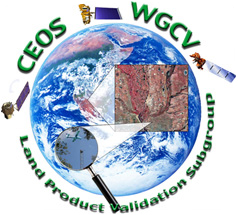
Focus Area on Vegetation Index Product Validation
Tomoaki Miura, University of Hawai'i, USA
Simon Kraatz, USDA, USA
Sarah Gebruers, VITO, Belgium
Vegetation Index Definition
Satellite-based vegetation index (VI) products are used to monitor temporal and spatial variations in vegetation density and health. VIs are arithmetic combinations of optical bands to measure vegetation canopy "greenness", a direct measure of photosynthetic potential resulting from the composite property of total leaf chlorophyll, leaf area, canopy cover, and structure. They are also widely used as proxies for estimating canopy state variables (leaf area index, fraction of absorbed photosynthetically-active radiation, chlorophyll content, vegetation fraction) and canopy biophysical processes (photosynthesis, transpiration, net primary production).
In general, a vegetation index combines surface reflectance in two or more spectral bands, often red and near-infrared. They vary from simple ratioing, to linear combination, to more complex calculation schemes. The aim of combining bands is to minimize the effect of external factors, such as the atmosphere, or internal, such as sensor noise, from the satellite signal. More commonly used satellite vegetation indices are the normalized difference vegetation index (NDVI) and the enhanced vegetation index (EVI) while there are many others.
Units: unitless [ratio]
Highest Validation Stage Currently Reached for Satellite-Derived Vegetation Indices
Validation stage 3 (LPV validation stage hierarchy) - Satellite VI products have been validated into various validation stages at their respective institutions. For example, MODIS VI products have reached validated stage 3, whereas VIIRS NASA VI products have achieved validation stage 1. The CEOS LPV Vegetation Index focus area is currently developing a validation good practices protocol with which every VI product?s validation status can be measured and established in a universal fashion.
Validation Good Practices
The CEOS LPV Vegetation Index focus area is currently developing a good practices protocol for the validation of satellite-derived VI products. The three components listed below are considered needed to characterize VI uncertainties and to satisfy the user needs:
- uncertainty of VIs in their units
- characterization of VI value changes with respect to changes in actual vegetation conditions (biophysical and/or physiological)
- long-term stability of VI time series datasets
This CEOS LPV focus area recommends that validation documents of a VI product include:
- product QA information
- uncertainty information acquired via validation
- product inter-comparison results
Approaches and methodologies used in previous studies are being evaluated and considered for incorporation into the protocol. These include:
- Inter-comparison or cross-comparison of VI products from similar satellites (e.g., MODIS, VIIRS, SeaWiFS, and SPOT VGT) or from satellites with differing spatial resolutions (e.g., MODIS vs. Landsat)
- Using AERONET-corrected surface reflectance from the same sensor data as a reference
- In situ reflectance data (e.g., ground-, tower-, and UAV-measured reflectance)
- In situ time series measurements of vegetation productivity (e.g., biomass, GPP, and crop phenology) or environmental condition (e.g., precipitation)
- Error analysis/error budget analysis
One of the outcomes of a recent VI focus area workshop was to adopt the "time series validation" approach as a standard VI validation methodology. This approach focuses on validating the quality of VI time series data, or assessing how well VI products capture the seasonal evolution of vegetation. TIme series data considered for this approach include: NPN, Phenocam, PEN, and FLUXNET (see below).
Potential Vegetation Index Validation Reference Data Sets
- NEON Airborne Hyperspectral Data
- AERONET-based Surface Reflectance Dataset
- Ground and Drone Observational Reflectance Data
- FLUXNET
- Phenological Eyes Network (PEN) Field Spectrometer Time Series Data
- Opportunistic unmanned aerial vehicle (UAV) Long-Term Agroecosystem Research (LTAR) Network Data
- High-resolution satellite data validated against ground measurements
- Fiducial reference measurement for vegetation (FRM4VEG)
- HYPERNETS (from 2022)
LPV Focus Areas
Meetings
EGU 2017, 23-28 April 2017, Vienna, Austria. Abstract submission due 11 Jan 2017, details here.
ESA Annouces first gathering of the Sentinel-2 Validation Team (S2VT), 8-29 November 2016, at ESRIN, Frascati, Italy.
- NASA Official: Sadashiva Devadiga
- Website Manager: Jaime Nickeson
- Last Updated: November 6, 2025


